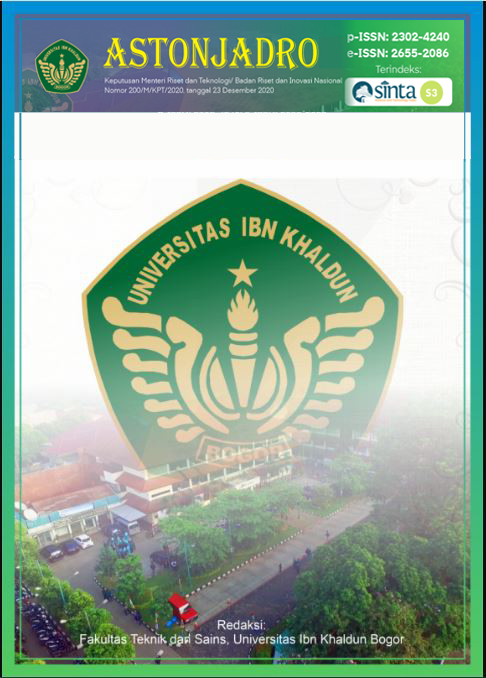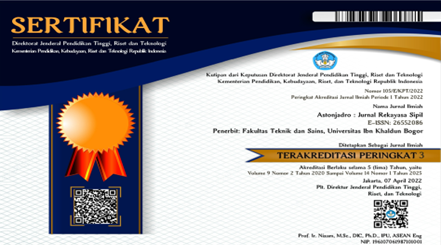Assesment of Enviromentally Friendly Transportation to Achieve Sustainable Transportation in Semarang City
DOI:
https://doi.org/10.32832/astonjadro.v14i1.17062Keywords:
transportation; environment-friendly transportation; green transportation; sustainable transportation; congestion; air pollution.Abstract
Transportation is the main infrastructure that has a role in driving the economy. The transportation sector can also be a problem if mobility is not accompanied by the availability of adequate infrastructure. Semarang City has the highest number of vehicles compared to other cities or regencies in Central Java Province. Based on data from BPS Semarang City, the number of motorized vehicles in Semarang City in 2021 reached 1,875,781 vehicles with the growth of motorized vehicles increasing by 12% every year. The high number of motorized vehicles in Semarang City causes congestion, air pollution and increases fuel consumption. Semarang City has started to initiate and design an environmentally friendly transportation system that leads to green transportation. The concept of green transportation is an environmentally friendly and sustainable transportation that aims to reduce vehicle emissions and create road space for pedestrians and bicycles. This is in line with the mission of Semarang City in realizing quality infrastructure that is environmentally sound and sustainable. The purpose of this study is to examine the implementation of green transportation that has been carried out in Semarang City in achieving sustainable transportation. This research uses a qualitative approach, This research uses a qualitative approach, while the analysis is carried out by descriptive analysis as well as scoring and weighting analysis so as to obtain the results of the value of the application of environmentally friendly transportation that leads to the concept of green transportation. The results obtained show that Semarang City in implementing environmentally friendly transportation that leads to green transportation has been quite good or quite successful.
References
Abdel Wahed Ahmed, M. M., & Abd El Monem, N. (2020). Sustainable and Green Transportation for Better Quality of Life Case Study Greater Cairo - Egypt. HBRC Journal, 16(1), 17–37.
BPS Kota Semarang. (2023). Kota Semarang Dalam Angka 2023.
Brotodewo, N. (2010). Penilaian Indikator Transportasi Berkelanjutan Pada Kawasan Metropolitan di Indonesia. Jurnal Perencanaan Wilayah Dan Kota, 21(3), 165–182.
Gusnita, D. (2010). Green Transport : Transportasi Ramah Lingkungan Dan Kontribusinya Dalam Mengurangi Polusi Udara. Berita Dirgantara, 11(2), 66–71.
Laeis, Z. (2018). Semarang Makin Macet, Berapa Jumlah Kendaraan Beredar? https://www.antaranews.com/berita/693566/semarang-makin-macet-berapa-jumlah-kendaraan-beredar
Li, H. R. (2016). Study on Green Transportation System of International Metropolises. Procedia Engineering, 137, 762–771.
Litman, T. (2003). Sustainable Transportation Indicators. Victoria Transport Policy Institute, 100.
National Academies of Sciences Engineering and Medicine. (2011). Sustainable Pavement Maintenance Practices. Washington, DC: The National Academies Press.
Pemerintah Kota Semarang. (2021). Rancangan Akhir Rencana Pembangunan Jangka Menengah Daerah (RPJMD) Kota Semarang Tahun 2021-2026.
Peraturan Daerah Kota Semarang. (2021). Peraturan Daerah Tentang Perubahan Atas Daerah Nomor 14 Tahun 2011 Tentang Rencana Tata Ruang Wilayah Kota Semarang Tahun 2011-2031 (Perda No 5 Tahun 2021).
Saragi, T. E. (2015). Pengaruh Sistem Penanganan Transportasi Yang Berkelanjutan Terhadap Lingkungan Di Perkotaan. Jurnal Fakultas Teknik, 1(3), 49–63.
Sismanto, A. (2018). Pertumbuhan Jalan Tak Sebanding, Kemacetan Ancam Semarang. https://daerah.sindonews.com/berita/1290647/22/pertumbuhan-jalan-tak-sebanding-kemacetan-ancam-semarang?showpage=all
Sugiyono. (2014). Metode Penelitian Kuantitatif Kualitatif Dan R&D. Bandung: Alfabeta.
The Centre for Sustainable Transportation. (2002). Definition and Vision Of Sustainable Transportation. Canada: The Centre for Sustainable Transportation.
Utama, D. A. (2019). BMKG Duga Polusi Udara di Semarang Akibat Asap Kendaraan dan Bakar Sampah Sembarangan. https://www.merdeka.com/peristiwa/bmkg-duga-polusi-udara-di-semarang-akibat-asap-kendaraan-dan-bakar-sampah-sembarangan.html
Downloads
Published
How to Cite
Issue
Section
License
Copyright (c) 2025 ASTONJADRO

This work is licensed under a Creative Commons Attribution-ShareAlike 4.0 International License.
Paper submitted to ASTONJADRO is the sole property of the Astonjadro Journal. Unless the author withdraws the paper because he does not want to be published in this journal. The publication rights are in the journal Astonjadro.ASTONJADRO
LICENSE
This work is licensed under a Creative Commons Attribution-ShareAlike 4.0 International License.
Based on a work at http://ejournal.uika-bogor.ac.id/index.php/ASTONJADRO













